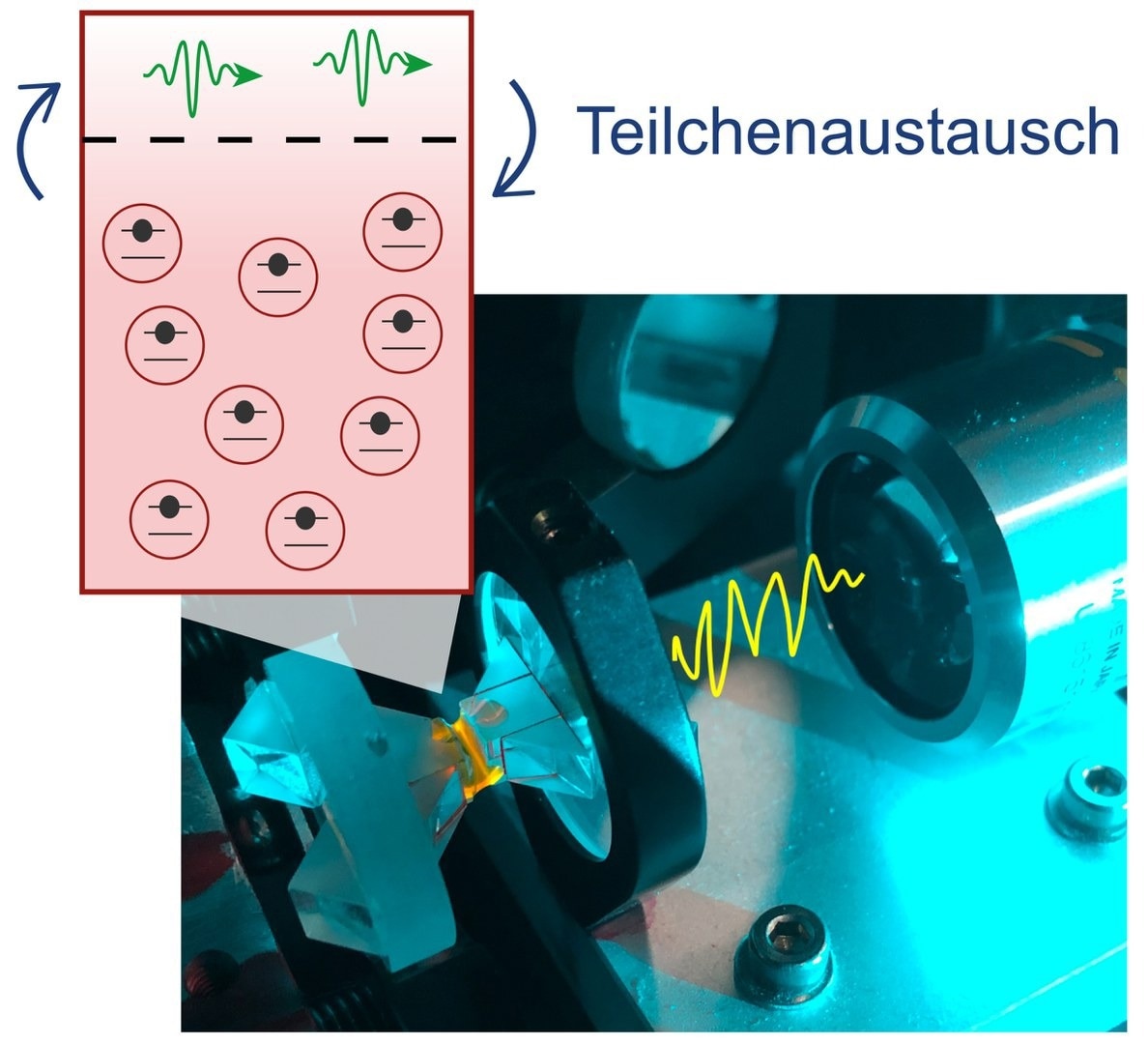At the University of Bonn, experimental proof has been given by physicists that a significant theorem of statistical physics relates to the “Bose-Einstein condensates.”

Photons (green) - can be “swallowed” by the dye molecules (red) and later "spat out" again. The more likely this is, the more the photon number fluctuates. Image Credit: J. Schmitt/University of Bonn
At present, their outcomes make it feasible to quantify a few properties of the quantum “superparticles” and infer system characteristics that would otherwise be difficult to notice. The study has currently been reported in the Physical Review Letters journal.
Imagine having a container filled with a liquid. The aim is to identify how much the particles in it (molecules or atoms) move back and forth randomly as a result of their thermal energy. However, there is no microscope with which one could imagine these position fluctuations, called the “Brownian motion.”
The more force is applied, the more viscous the liquid becomes. Also, the more viscous it is, the lesser the particles in the liquid tend to alter their position on average. Hence, the viscosity at a given temperature could be utilized to forecast the fluctuation scope.
The so-called fluctuation-dissipation theorem is the physical law that explains this basic relationship. It states: The greater the force required to disturb a system from the outside, the less it will also fluctuate randomly (i.e., statistically) on its own if you leave it alone.
We have now confirmed the validity of the theorem for a special group of quantum systems for the first time: the Bose-Einstein condensates.
Dr. Julian Schmitt, Institute of Applied Physics, University of Bonn
“Super Photons” Made of Thousands of Light Particles
The condensates of Bose-Einstein are known to be exotic forms of matter that has the potential to emerge as a result of a quantum mechanical effect: Under some conditions, particles, be they molecules, atoms, or even photons (particles that form light), become indistinct. Several hundred or thousands of them unite into a single “super particle,” the Bose-Einstein condensate (BEC).
Molecules will move back and forth in a random manner in a liquid at a finite temperature. The warmer the liquid is, the more pronounced such thermal fluctuations are. Also, Bose-Einstein condensates can fluctuate: The number of condensed particles gets altered. Also, this fluctuation increases with increasing temperature.
If the fluctuation-dissipation theorem applies to BECs, the greater the fluctuation in their particle number, the more sensitively they should respond to an external perturbation” Unfortunately, the number fluctuations in the usually studied BECs in ultracold atomic gases is too small to test this relationship.
Dr. Julian Schmitt, Institute of Applied Physics, University of Bonn
But the research team of Professor Dr. Martin Weitz, within which Schmitt is a junior research group leader, works with Bose-Einstein condensates made out of photons. Also, for this system, the limitation is not applicable.
“We make the photons in our BECs interact with dye molecules,” describes the physicist, who recently won a highly granted prize for young scientists from the European Union, called an ERC Starting Grant.
When there is an interaction of photons with dye molecules, what happens is that a molecule “swallows” a photon. Thus, the dye turns out to be excited in an energetic manner. Later, it can discharge this excitation energy by “spitting out” a photon.
Low-Energy Photons Are Swallowed Less Often
Due to the contact to the dye molecules, the number of photons in our BECs shows large statistical fluctuations.
Dr. Julian Schmitt, Institute of Applied Physics, University of Bonn
Besides, it is possible for scientists to accurately regulate the strength of this difference: In the experiment, the photons have been caught between two mirrors, where they have been reflected back and forth in a ping-pong game manner.
There can be a change found in the distance between the mirrors. The bigger it becomes, the lesser the energy of the photons. As the low-energy photons are less likely to excite a dye molecule (so they are swallowed more rarely), numerous condensed light particles currently fluctuate even less.
At present, the physicists from Bonn examined how the extent of the fluctuation has been associated with the BEC “response.” If the fluctuation-dissipation theorem holds, this sensitivity must reduce as fluctuation decreases.
“In fact, we were able to confirm this effect in our experiments,” stresses Schmitt, who is also a member of the Transdisciplinary Research Area (TRA) “Matter” at the University of Bonn and the Cluster of Excellence “ML4Q - Matter and Light for Quantum Computing.”
As far as liquids are concerned, it is currently possible to deduce the microscopic properties of Bose-Einstein condensates from macroscopic response parameters that could be quantified in a simpler manner.
“This opens a way to new applications, such as the precise temperature determination in complex photonic systems,” states Schmitt.
The project was financially supported by the German Research Foundation (DFG) as part of the EU project “Photons for Quantum Simulation,” and the German Federal Ministry of Economic Affairs and Climate Action (BMWK).
Journal Reference:
Öztürk, F. E., et al. (2023) Fluctuation-Dissipation Relation for a Bose-Einstein Condensate of Photons. Physical Review Letters. doi.org/10.1103/PhysRevLett.130.033602.